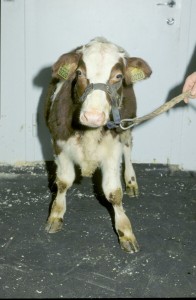Infection of cattle with pestiviruses can cause bovine viral diarrhoea (BVD) and, in some cases, mucosal disease. In pregnant animals, infection can also result in reproductive failure or persistently infected (PI) offspring. These PI animals produce and excrete the virus, usually at high concentrations, throughout their lives and are instrumental in the spread of infection, being the main reservoir of the virus. During the late 1980s, it became increasingly evident that BVD-related losses were economically significant to the livestock industry in Norway and that direct losses were estimated to be around 50 million Norwegian crowns (NOK) (£4.5 million).
A paper recently published in Veterinary Record by Torleiv Loken and Ola Nyberg describes a collaborative project that ran from December 1992 until 2004 with the intention of eradicating pestiviruses from the Norwegian cattle population.1 The collaborative project involved four key partners: the Norwegian Animal Health Authorities (NAH), the National Veterinary Institute, the cattle owners, and the cattle industry comprised of three farmers’ associations.
Loken and Krogsrud developed a strategy in 1992 based on the identification and culling of all PI animals2, and testing was performed in four tiers:
• Tier 1 Annual screening for antibodies in bulk milk from all herds.
• Tier 2 Herds found positive in tier 1 were examined for antibodies in pooled milk samples from primiparous cows.
• Tier 3 Herds found positive in tier 2 were examined for antibodies in pooled blood samples from young stock. These herds were subject to restrictions.
• Tier 4 Antibody-negative animals in herds that were found positive in tier 3 were tested for pestivirus antigen in blood and, if positive, were designated as a PI animal.
Following the culling of PI animals, a herd was considered to be free from pestivirus when pooled blood from youngstock was antibody negative on two sampling occasions, three months apart.
The number of herds with PI animals peaked at about 3000 in the second year of the project, and then decreased steadily. The last four PI cattle from the same herd were detected in 2005 and were immediately culled. Since then the surveillance programme has not detected any dairy cattle or beef animal positive for pestivirus. A cost benefit analysis estimated that the project has saved the Norwegian dairy industry losses of between 50 million to 200 million NOK annually (approximately £4.5 million to 18 million GBP). The total running cost of the project over 10 years was 52.4 million NOK. This, the authors say, clearly demonstrates that the project was economically highly beneficial. Subsequently, the value of close surveillance of the national cattle population has been emphasised to ensure that the cattle remain free from infection.

The authors conclude that the pestivirus eradication project was successful, resulting in the elimination of BVD and mucosal disease in the Norwegian cattle population and was economically highly beneficial. Torleiv Loken praised the determination of the collaborators for the success of the project:
‘The story starts with the first demonstration of border disease in a lamb in Norway, which I published in 1981. The next year I diagnosed border disease in a liveborn kid, which was the first known diagnosis of border disease in a kid. That really tickled my interest and curiosity, and I went on to research pestivirus in cattle as well, which at the time was diagnosed very rarely in Norway. Along the line, the veterinarians and the cattle owners became very interested in pestivirus-related diseases and understood it could be very costly in a herd. The cattle owners pushed for more studies, and soon wanted – actually demanded – the eradication of this microbe. This willingness from the farmers to contribute to an eradication programme, both practically and economically, with strong support from the authorities, I think was one of the most important and basic keys to success.’
References
- Loken, T. & Nyberg, O. (2013) Eradication of BVDV in cattle: the Norwegian project. Veterinary Record doi: 10.1136/vr.101525
- Loken, T & Krogsrud J. (1992) Programme for making the Norwegian cattle free from pestivirus. Proceedings of the 2nd Symposium on Ruminant Pestiviruses. Annecy, European Society for Veterinary Virology. 1992. P66